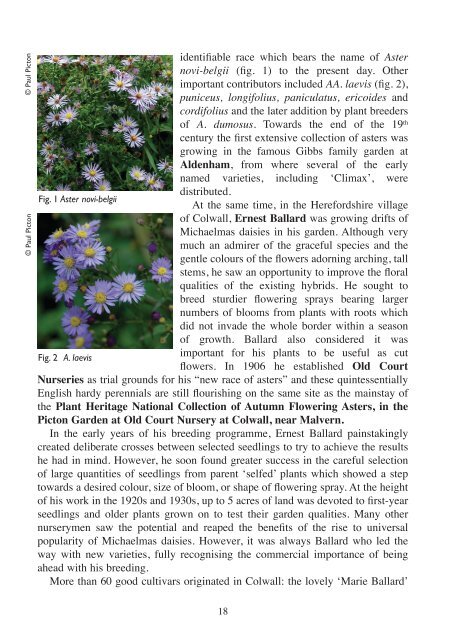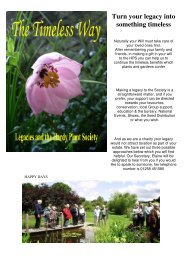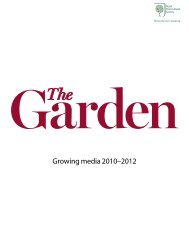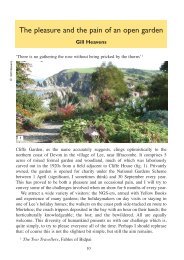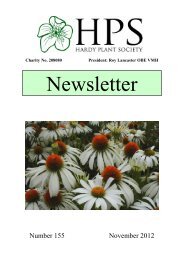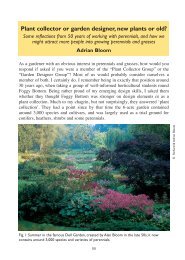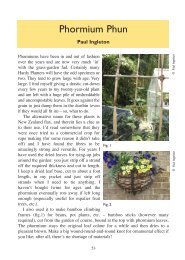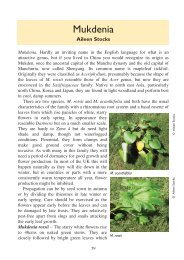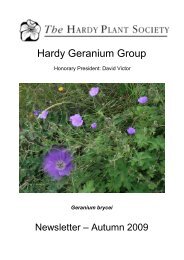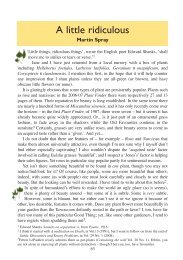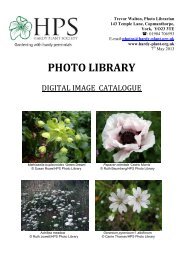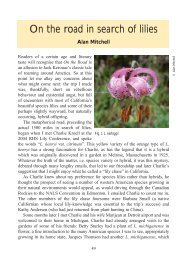Aster novi-belgii - Hardy Plant Society
Aster novi-belgii - Hardy Plant Society
Aster novi-belgii - Hardy Plant Society
Create successful ePaper yourself
Turn your PDF publications into a flip-book with our unique Google optimized e-Paper software.
© Paul Picton<br />
© Paul Picton<br />
identifiable race which bears the name of <strong>Aster</strong><br />
<strong>novi</strong>-<strong>belgii</strong> (fig. 1) to the present day. Other<br />
important contributors included AA. laevis (fig. 2),<br />
puniceus, longifolius, paniculatus, ericoides and<br />
cordifolius and the later addition by plant breeders<br />
of A. dumosus. Towards the end of the 19th century the first extensive collection of asters was<br />
growing in the famous Gibbs family garden at<br />
Aldenham, from where several of the early<br />
named varieties, including ‘Climax’, were<br />
distributed.<br />
Fig. 1 <strong>Aster</strong> <strong>novi</strong>-<strong>belgii</strong><br />
At the same time, in the Herefordshire village<br />
of Colwall, Ernest Ballard was growing drifts of<br />
Michaelmas daisies in his garden. Although very<br />
much an admirer of the graceful species and the<br />
gentle colours of the flowers adorning arching, tall<br />
stems, he saw an opportunity to improve the floral<br />
qualities of the existing hybrids. He sought to<br />
breed sturdier flowering sprays bearing larger<br />
numbers of blooms from plants with roots which<br />
did not invade the whole border within a season<br />
of growth. Ballard also considered it was<br />
Fig. 2 A. laevis<br />
important for his plants to be useful as cut<br />
flowers. In 1906 he established Old Court<br />
Nurseries as trial grounds for his “new race of asters” and these quintessentially<br />
English hardy perennials are still flourishing on the same site as the mainstay of<br />
the <strong>Plant</strong> Heritage National Collection of Autumn Flowering <strong>Aster</strong>s, in the<br />
Picton Garden at Old Court Nursery at Colwall, near Malvern.<br />
In the early years of his breeding programme, Ernest Ballard painstakingly<br />
created deliberate crosses between selected seedlings to try to achieve the results<br />
he had in mind. However, he soon found greater success in the careful selection<br />
of large quantities of seedlings from parent ‘selfed’ plants which showed a step<br />
towards a desired colour, size of bloom, or shape of flowering spray. At the height<br />
of his work in the 1920s and 1930s, up to 5 acres of land was devoted to first-year<br />
seedlings and older plants grown on to test their garden qualities. Many other<br />
nurserymen saw the potential and reaped the benefits of the rise to universal<br />
popularity of Michaelmas daisies. However, it was always Ballard who led the<br />
way with new varieties, fully recognising the commercial importance of being<br />
ahead with his breeding.<br />
More than 60 good cultivars originated in Colwall: the lovely ‘Marie Ballard’<br />
18


